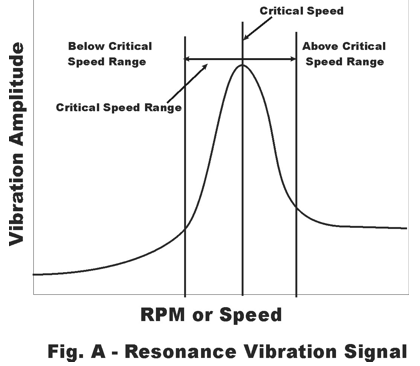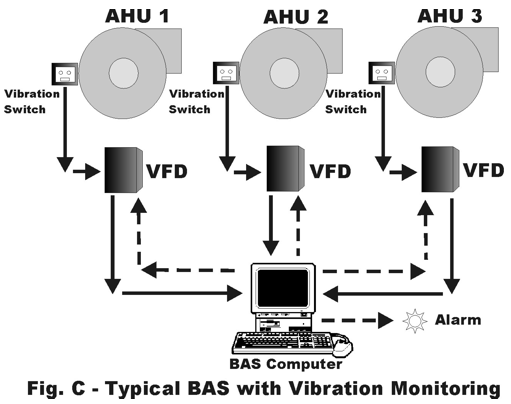May 2004
![]()
AutomatedBuildings.com
[an error occurred while processing this directive]
(Click Message to Learn More)
May 2004 |
[an error occurred while processing this directive] |
|
|
Mark Slebodnik |
Introduction
Vibration is a fundamental problem confronting building owners, design engineers, contractors and facilities managers working in today's commercial building industry.
|
[an error occurred while processing this directive] |
Vibration causes tenant complaints, owner dissatisfaction and even litigation. Vibration is often the main source of noise problems. Abnormal vibration is expensive. Unchecked vibration results in broken machinery, expensive repairs and even structural damage.
The best answer available today to this problem is simple and economical: vibration monitoring. Vibration monitoring is a proven technology. Vibration monitoring has been used successfully for decades - in hundreds of thousands of industrial applications around the world.
Typically, the root causes of vibration problems are the same, whether the application is a processing plant, or a school, hospital or office building.
Commercial building owners, engineers, contractors and facilities managers can borrow a page from industrial vibration monitoring technology and solve today's vibration problems facing the commercial building industry.
Industrial Processes
and Variable Frequency Drives
For decades, industrial plants have used combinations of Variable Frequency
Drives (VFD's) and Programmable Logic Controllers (PLC's) to run processes.
Combinations of VFD's and PLC's improve process control and reduce operational
costs. They allow automated control systems to vary process speeds according to
immediate process requirements: faster when demand is high, slower when demand
is low.
However, most motors, fans and pumps are designed to operate optimally at a single speed. Increasing or decreasing the operational speed often causes the motor to run at a speed that corresponds to a natural frequency of the system. In general, any speed which is associated with very high vibration is often called a "critical speed." Running at the critical speed produces severe vibration. (Fig A. - Resonance Vibration Signal) Unchecked, this severe vibration can result in premature failures, broken parts and even catastrophic breakdowns.
|
Critical Speeds, Natural Frequency and Resonance Critical speed is a condition identified by severe vibration that occurs when a part runs at the same speed as its own natural frequency. In fact, natural frequency, critical speed and resonance are terms that are used interchangeably to describe a source of extremely high vibration in rotating machinery. Think of the sound you hear when you hit a bell with a hammer. That sound is the bell's natural frequency (resonance or critical frequency) after being excited by the hammer's blow. When a part is excited and vibrates at it's natural frequency, the condition is called "in resonance." Motors, fans and pumps all have natural frequencies. So do the mechanical structures on which they are mounted. If a motor runs at its critical speed, the motor will shake severely. Sometimes, it excites the natural frequency of the mounting structure, and the entire motor and structure shakes violently. Resonance typically leads to premature failed bearings and loosened, weakened or broken supports. Unchecked resonance can lead to catastrophic situations such as fan blades and welds coming apart and destroying the surrounding structure. |

BAS and VFD's
Building Automation Systems (BAS's) use VFD's to control the speeds of
motors, fans and pumps that heat and cool a building. By controlling equipment
operations to match the needed comfort demands, owners realize thousands of
dollars of savings in energy use throughout the year.
In small and medium size buildings, BAS/VFD combinations typically control one or two large supply and return fans. In large buildings, BAS/VFD's control many motors, fans and pumps to regulate temperatures in several "zones" throughout the building. These systems include equipment located on rooftops, in mechanical rooms and in physical equipment rooms.
As the VFD changes the operating speed, increasing or decreasing the frequency, it can cause the equipment to slip into resonance. When this occurs, the severe vibration can excite the natural frequency of the system. Depending on the type of equipment and the way it is attached to the surrounding structure, the severe vibration may remain localized. Damage may be limited to bearing failures and broken mountings. However, if the resonance remains unchecked during a period when the building is unattended, the damage could be more severe (and costly) such as broken bearings and machinery.
Another phenomenon that occurs with fans in resonance is that the vibration can migrate into the connecting air ducts and travel throughout other parts of the building. When this condition occurs, the results vary from increased perceptible noise to vibrating desks and furniture.
Vibration Monitoring
[an error occurred while processing this directive]For
years, plant owners, contractors and maintenance managers have used vibration
monitoring to pinpoint the critical speeds in their processes. They adjust the
control process to lock out specific speed ranges so the equipment does not
operate at a critical speed. They optimize the process while fully realizing the
benefits of VFD control and minimizing the disadvantages.
This same technology can be applied to commercial applications using BAS and VFD combinations.
What kinds of
Vibration Monitors are available?
Several types of vibration monitors are available with various features and
prices. These monitors include vibration sensors and meters. Some vibration
sensors (accelerometers) have an attractive low initial cost but require
additional components and electronic instrumentation to complete the
"system."
The most common and effective monitor for commercial use with BAS's and VFD's is the stand-alone, DC powered vibration switch. Switches mount directly on the motor, fan or pump and interface with the VFD. They feature vibration limit settings, contact relays for control and indicator lights (LEDs) for status.
How Switches Work
The switch is mounted directly to the fan, motor or pump housing with simple
hardware. DC power is applied to the switch and the output from the switch relay
contact is interfaced with the control circuit of the VFD.
Switches are factory calibrated in vibration units of velocity (inches per second). Limits come preset from the factory, or can be adjusted on site. Typical limits range from 0.1 inch per second up to 2.0 inches per second.
Switches feature limit time delays. Time delays are designed to prevent nuisance trips from large transient vibrations that can occur during start-up and shut-down operations.
When the vibration level of the equipment being monitored exceeds the preset vibration limit of the switch and continues for a period exceeding the time delay setting, the switch relay will trip. This relay can be used to control the VFD and provide immediate shut-down. It can also be used to provide an alarm at the BAS computer to alert the facilities manager of a problem.

Switches provide round the clock monitoring of critical equipment - even during periods when the building is unattended. They can help prevent costly damage to motors, fans and pumps and eliminate major repair costs.
Additionally, vibration switches provide these benefits:
Benefits to Building Owners
Identifies equipment installation problems during new equipment commissioning periods
Identifies tenant abuse of equipment such as operation of motors and fans outside good, normal speed ranges
Pays for itself in longer equipment life and eliminates maintenance and repair costs
Stops tenant complaints about noise and vibration
Monitors equipment in unattended buildings and mechanical room 24/7.
Benefits for the Design Engineer
Pinpoints equipment installation problems on start-up while equipment under warranty
Establishes baseline records and trends system performance to support design specifications
Allows quick and efficient BAS optimization to reduce start up time
Benefits to Facilities Managers
Stops nuisance calls from building occupants regarding noise and vibration
Stops emergency maintenance and repair projects on equipment
Smoother relations with building owners
[an error occurred while processing this directive]Summary
Lower energy costs, greater efficiency and more capacity are benefits that
building owners demand from BAS/VFD technology. BAS/VFD technology is the new
prerequisite to faster ROI.
While the application is new, the technology is not. Varying motor, fan and pump speeds to match process demands has been used for years in industrial applications. And years ago, industrial engineers learned there are limitations to the technology.
Motors, fans and pumps have inherent design restrictions. One of the restrictions is running a component at its critical speed. Running a fan at critical speed causes severe vibration which results in mechanical and even catastrophic failure.
For many years, industrial engineers have known to use vibration monitoring to prevent motors, fans and pumps from running at their critical speed. The Vibration Switch has proved to be the most efficient and economical choice of engineers to optimize their processes and safeguard their machines.
Today, building owners, design engineers and facilities managers can borrow a page from industrial process control and apply Vibration Switches to their mechanical systems to achieve the most efficiency and optimize their BAS/VFD systems.
Appendix
Reference Illustrations and Diagrams
Fig. A - Resonance Vibration Signal
Fig. C - Typical BAS with Vibration Monitoring
[an error occurred while processing this directive]
[Click Banner To Learn More]
[Home Page] [The Automator] [About] [Subscribe ] [Contact Us]